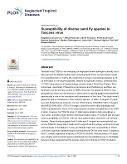Susceptibility of diverse sand fly species to Toscana virus

Author
Thiesson, Adrien
Arnaud, Frédérick
Rehbergerová, Markéta
Kohl, Alain
Viginier, Barbara
Ratinier, Maxime
Publication date
2025Published in
PLoS Neglected Tropical DiseasesVolume / Issue
19 (5)ISBN / ISSN
ISSN: 1935-2727ISBN / ISSN
eISSN: 1935-2735Metadata
Show full item recordCollections
This publication has a published version with DOI 10.1371/journal.pntd.0013031
Abstract
Toscana virus (TOSV) is an emerging but neglected human pathogen currently circulating around the Mediterranean basin including North Africa. Human illness ranges from asymptomatic or mild flu-like syndromes to severe neurological diseases such as meningitis or meningoencephalitis. Despite its significant impact, understanding of TOSV transmission and epidemiology remains limited. Sand flies (Diptera: Phlebotominae), specifically Phlebotomus perniciosus and Phlebotomus perfiliewi, are believed to be the primary vectors of TOSV. However, the spread of TOSV to new geographical areas and its detection in other sand fly species suggest that additional species play a role in the circulation and transmission of this virus. This study investigated the vector competence of four sand fly species - P. tobbi, P. sergenti, P. papatasi, and Sergentomyia schwetzi - for two TOSV strains: 1500590 (TOSV A lineage) and MRS20104319501 (TOSV B lineage). Sand flies were orally challenged with TOSV via bloodmeals. None of the tested species showed susceptibility to the TOSV A strain. However, for TOSV B strain, P. tobbi demonstrated a high potential as a new vector, exhibiting high infection and dissemination rates. P. sergenti also showed some susceptibility to TOSV B, with the virus dissemination observed in all infected females. These finding suggests that P. tobbi and P. sergenti are new potential vectors for TOSV B. Given that P. tobbi and P. sergenti are the primary vectors of human leishmaniases in the Balkans, Turkey and Middle East, their susceptibility to TOSV could have significant epidemiological consequences. On the other hand, P. papatasi and S. schwetzi appeared refractory to TOSV B infection. Refractoriness of P. papatasi, a highly anthropophilic species distributed from the Mediterranean to the Middle East and India, suggests that this species does not contribute to TOSV circulation.
Keywords
Toscana virus (TOSV), Phlebotomus, circulation, transmission, human leishmaniases, sand flies, vector
Permanent link
https://hdl.handle.net/20.500.14178/3096License
Full text of this result is licensed under: Creative Commons Uveďte původ 4.0 International







